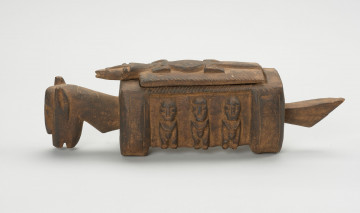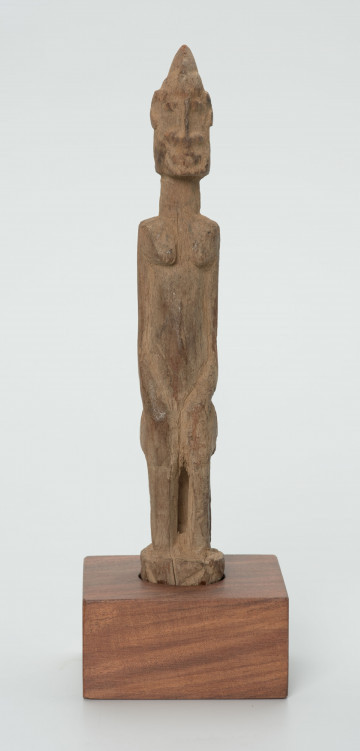Door lock with key
około 1970
National Museum in Szczecin
Part of the collection: Collection of Dogonian art
The Dogon makers are mostly jemu smiths (living on the Seno and Gondo Plains) and iru smiths (living on the Plateau). They are mainly specialists in the extraction and working of iron, but they are also considered masters of wood. Artistic activities, mainly mask and prop making, are also carried out by members of the Awa association. It is a secret society of circumcised men initiated into the mask cult, also known as Awa. The most famous carving material is wood; figures are also made of stone, iron and, more rarely, clay.The most crucial motif in Dogon art is figural representations of ancestors, which are placed on altars dedicated to them. There appear images of real and mythical, male, female and hermaphrodite ancestors.The Dogon usually depict human figures in a simplified manner. They are slender and have disproportionately large heads. Anatomical details are marked symbolically, but the ways of decorating the body are rendered carefully. The essential elements in the statuettes depicting women are the head and breasts, while in men's images, the arms and genitals. Often features characteristic for both sexes can be seen in one figure. Such a solution has its justification in the mythology of the Dogon. Among the eight prominent ancestors born from the first pair of humans formed by Amma, the four older ones were male and the four younger ones female. However, besides the characteristics of one sex, they were endowed with a unique gift of nature; namely, they possessed at the same time the features of the other sex, thanks to which they were able to impregnate themselves.
Ewa Prądzyńska
Author / creator
Dimensions
cały obiekt: height: 60 cm, width: 7,4 cm
Object type
sculpture
Creation time / dating
Creation / finding place
Identification number
Location / status
około 1970
National Museum in Szczecin

między 1951 — 2000
National Museum in Szczecin

między 1901 — 1950
National Museum in Szczecin
DISCOVER this TOPIC
Castle Museum in Łańcut
DISCOVER this PATH
Educational path